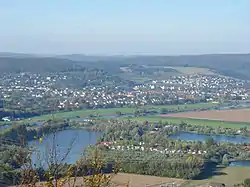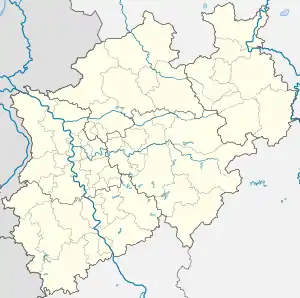Beverungen | |
|---|---|
 | |
|
Flag  Coat of arms | |
Location of Beverungen within Höxter district  | |
 Beverungen  Beverungen | |
| Coordinates: 51°39′46″N 9°22′21″E / 51.66278°N 9.37250°E | |
| Country | Germany |
| State | North Rhine-Westphalia |
| Admin. region | Detmold |
| District | Höxter |
| Subdivisions | 12 |
| Government | |
| • Mayor (2020–25) | Hubert Grimm[1] (Ind.) |
| Area | |
| • Total | 97.84 km2 (37.78 sq mi) |
| Elevation | 100 m (300 ft) |
| Population (2021-12-31)[2] | |
| • Total | 13,083 |
| • Density | 130/km2 (350/sq mi) |
| Time zone | UTC+01:00 (CET) |
| • Summer (DST) | UTC+02:00 (CEST) |
| Postal codes | 37688 |
| Dialling codes | 05273 |
| Vehicle registration | HX |
| Website | www.beverungen.de |
Beverungen (German pronunciation: [ˈbeːvəˌʁʊŋən] ⓘ) is a town in Höxter district in North Rhine-Westphalia, Germany.
Geography
Location
Beverungen lies in the Weser Uplands on the side of the Weser opposite Solling roughly 10 km south of Höxter. In parts of the eastern municipal area near the river, the town has a share of the Weser Valley, and to the west the higher Oberwälder Land natural region. In Beverungen (main town), the river Bever empties into the Weser.
Geopolitically, Beverungen thereby lies in eastern North Rhine-Westphalia at the three-state point shared with Lower Saxony and Hesse. The Weser forms the border with the former.
One peculiarity in the town's location is to be found at the constituent community of Würgassen (German pronunciation: [ˈvʏʁˌɡasn̩] ⓘ, which lies on the Weser's right (here, north) bank, which would actually mean that the community were in Lower Saxony had it not been for the way a long-standing boundary dispute was settled in 1837. Even today, the boundary does not quite put all the community in North Rhine-Westphalia; the local Shooting Brotherhood's shooting range still lies partly in North Rhine-Westphalia and partly in Lower Saxony.
Neighbouring communities
The town of Beverungen lies right at the point common to the Bundesländer of North Rhine-Westphalia, Lower Saxony and Hesse. It borders in the west on the towns of Borgentreich and Brakel, in the north on the town of Höxter (all in Höxter district), in the east on the Samtgemeinde of Boffzen with its member communities of Boffzen and Fürstenberg and the market town of Lauenförde (all in Holzminden district), and the municipality-free area of Solling (Northeim district), and in the south on the towns of Bad Karlshafen and Trendelburg (both in Kassel district).
Constituent communities
Beverungen consists of the following 12 centres:
- Beverungen
- Amelunxen
- Blankenau
- Dalhausen
- Drenke
- Haarbrück
- Herstelle
- Jakobsberg
- Rothe
- Tietelsen
- Wehrden
- Würgassen
History
The name "Beverungun" is known from as early as the mid 9th century. This was at first a noble estate with great landholdings, which soon developed into a village. About 1300, Bishop Bernhard of Paderborn began building work on the castle. The village was granted town rights in 1417. For over 500 years thereafter, Beverungen was a farming town.
The town reached both heights and depths through this time, one of the latter being the Plague striking the town in 1626, during the Thirty Years' War. The Hessians and the Swedes saw fit in 1632 to burn the town down, leaving only five houses standing afterwards. Thanks to the town's advantageous location, it soon recovered and quickly had a flourishing trade in grain, iron and glass from the glassworks in the Paderborner Land.
For centuries, Beverungen was the harbour town for the Prince-Bishopric of Paderborn. Even many people who went to the Americas began their journeys to the ocean steamers in Bremen here. Towards the end of the 19th century, a new economic upswing began with the railway's arrival and the building of a bridge across the Weser.
During World War II, a subcamp of Flossenbürg concentration camp was located here.[3]
The current town of Beverungen with its 12 constituent communities was created in 1970.[4]
Würgassen
Its existence witnessed by documentary proof from the 10th century, Würgassen likely already existed in Charlemagne's time. In 1698, the stately home (Schloss) was completed.
Although the local folklore holds that the village's name came about from the story in which "Charlemagne had the Würgassen dwellers strangled in the lanes for reverting to heathen customs", or in German, "Karl der Große hat die Würgasser wegen eines Rückfalles in heidnische Sitten in den Gassen erwürgen lassen", this is certainly untrue. Rather, the village's original name was Wirrigsen, more closely akin to the terms Wirura (the Weser) and Gisen (bubble up). As late as the early 20th century, the Weser at Würgassen was still underlain by a good many rocks, so that the water was churned up.
The villagers who did not work in agriculture in earlier days hired themselves out foremost as sailors in the shipping on the river Weser. In the 1970s, many people were employed at the newly built Würgassen Nuclear Power Plant, which was abandoned in 1995 and is now being dismantled.
Politics
Town council
Town council's 32 seats are apportioned as follows, in accordance with municipal elections held on 26 September 2004:
Coat of arms
Beverungen's civic coat of arms might heraldically be described thus: In azure three fleurs-de-lis argent, two above, one below.
The fleur-de-lis only appeared in the town's official seal in the 17th century. At first, there was only one, but the now familiar design with three came into use in the 18th century. The charge is believed to represent the Bishop of Paderborn. The arms were officially conferred on 12 May 1917, and confirmed in 1970.
The current arms do not bear any likeness to the original town seal, which came into use at the time when Beverungen was granted town rights. This seal showed a town gate and Saint Vitus.
Economy and infrastructure
Transport
Beverungen is served by Lauenförde-Beverungen station on the Solling Railway (Sollingbahn) in the neighbouring community of Lauenförde, which is close to Beverungen. Trains run hourly to Ottbergen and Bodenfelde; from Bodenfelde, trains run to either Northeim or Göttingen. From Ottbergen there are connections to Altenbeken, Paderborn and Holzminden. Furthermore, the constituent community of Wehrden has a halt on the same line.
Public institutions
- Public Internet café
- Festival hall
- Würgassen nuclear power station (derelict)
Education
Beverungen has a school centre with a Hauptschule, a Realschule and a Gymnasium to which go students not only from Beverungen, but also from the neighbouring communities of Lauenförde in Lower Saxony and Trendelburg-Langental in Hesse.
Events
In Beverungen, a shooting festival is held every other year. Every year at Whitsun, the "Orange-Blossom-Special" – a music festival hosted by the local record label/mail order company, Glitterhouse Records – is held. Some 2000 visitors attend from all over Europe.
Twin towns – sister cities
Beverungen is twinned with:[5]
 Briouze, France
Briouze, France
References
- ↑ Wahlergebnisse in NRW Kommunalwahlen 2020, Land Nordrhein-Westfalen, accessed 21 June 2021.
- ↑ "Bevölkerung der Gemeinden Nordrhein-Westfalens am 31. Dezember 2021" (in German). Landesbetrieb Information und Technik NRW. Retrieved 20 June 2022.
- ↑ Christine O'Keepe.Concentration Camps.www.tartanplace.com/tartanhistory/concentrationcamps.html
- ↑ "Moderne Kleinstadt mit altem Gesicht" (in German). Archived from the original on 2011-07-19. Retrieved 14 January 2012.
- ↑ "24 jumelages franco-allemands dans l'Orne". Ouest-France.fr. 21 January 2013.